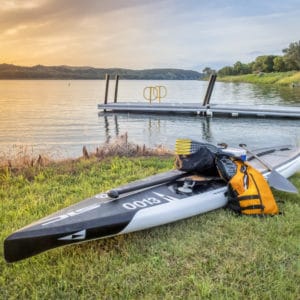Choosing your first kayak is a bit like choosing your first car. Choose a super-fast and shiny Porsche to use in the city and you’ll be disappointed. You won’t be able to make use of its powerful engine, and any little accident will make for an expensive repair bill.
On the flip side, if you’re 6ft tall and you choose a small FIAT 500, you’ll probably hate driving as you’ll feel confined and your legs will hurt.
In this kayak buying guide, we’ll cover everything you need to know to choose your first kayak based on your specific needs—because you deserve a custom boat.
A word of caution
Don’t buy a kayak before you’ve read this section!
Rent before buying
In this article, we’re going to help you choose the kayak that will best match your intended use.
However, you may find that your needs will change over time. For instance, it’s fairly common for people to start kayaking in the summer with their family, and they soon find out that they actually love kayaking and that they want to use their kayak in the winter too, and on longer distances. For this reason, it’s better to rent a kayak first before buying one.
Buy second hand
Even when you think you are ready to buy a kayak that will suit you, I’d still recommend you to buy second-hand first. Because again, your needs may and will change over time as you acquire more skills. By buying a used kayak, you can often resell it for the same price afterward and buy another, more suited kayak.
Additionally, you may well find out that you like an older kayak better than a newer one. So don’t fall for the “new” aspect of a kayak and the bells and whistles that come with it, as sometimes it will fail you on more important things like comfort and size.
I recommend watching the video below to learn how to get a good deal on second-hand kayaks, by using Craigslist.
Types of Kayaks
The first choice you’ll have to make before choosing a kayak is between sit-in and sit-on-top. To give you a very broad overview, sit-in kayaks are better suited for “experienced” or “serious” kayakers while sit-on-tops are better to have fun in the summer with your family.
But there’s much more to it, so read on to learn how to choose between a sit-in or sit-on-top kayak
Sit-in vs sit-on-top
The first thing to consider is if you’ll be using your kayak on warm or cold water. Will you use it during summer, or during winter?
Sit-in kayaks
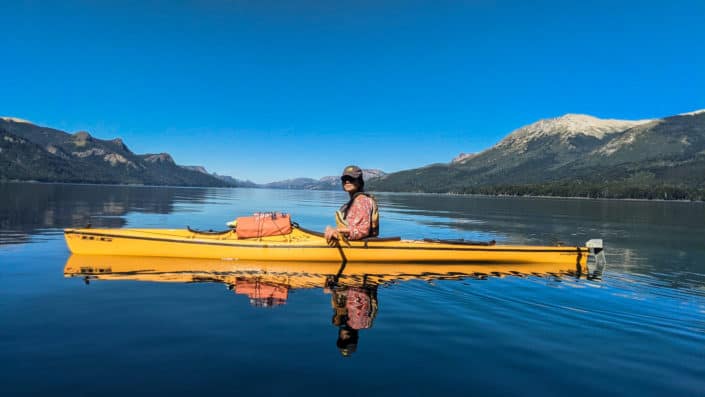
Sit-in kayaks have a closed cockpit, which helps you stay dry and makes them ideal during the winter. You can also buy a spray-skirt to make your kayak completely splash-proof.
Because you’re inside the kayak, they also tend to fare much better in windy conditions. Paddling will be easier and more efficient, and even more so thanks to their lower center of gravity.
They also have more storage space, which is particularly helpful if you want to go camping.
Finally, don’t be afraid of feeling confined in a sit-in kayak. They come in different cockpit sizes, and you’ll easily find one in which you feel comfortable.
Sit-on-top kayaks
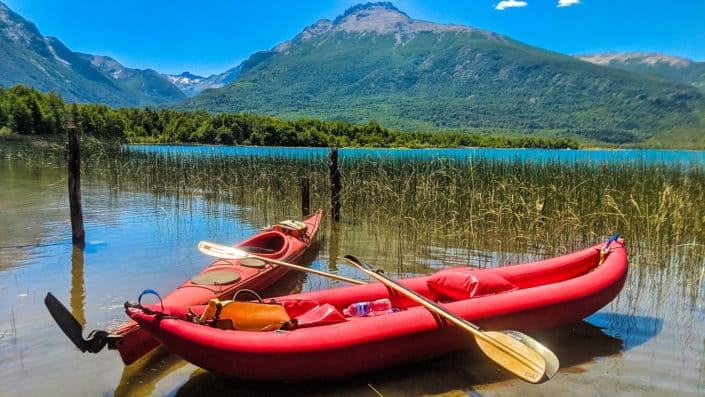
About one out of five kayaks purchased is a sit-on-top kayak, and for good reason: they’re great to have a fun summer with your family.
Indeed, as opposed to sit-ins, sit-on-top kayaks are great when you want to get splashed to cool off. They will also let you soak in the sun, as well as get on and off to swim and snorkel, which is particularly useful if you go kayaking with kids.
Another advantage of sit-on-top kayaks is that they are self-bailing thanks to “scupper holes”. This means you don’t need a bilge pump, as opposed to a sit-in kayak
Finally, sit-on-top kayaks are more stable and perfectly suited for beginners who are afraid of capsizing. They’re also great to paddle with kids as they minimize dangers and maximize amusement.
Different uses
Depending on where and what you will use your kayak for, you will have to choose between different types of kayaks.

Indeed, certain kayaks are more maneuverable and therefore great for strong currents, whereas others track better (go forward) which makes them ideal for the open ocean or long distances.
- Recreational kayaks: As the name suggests, these kayaks are perfect for beginners who want to get their feet wet. They are very stable and are usually best suited for calm waters like a small lake.
- Touring/sea kayaks: Touring kayaks are better for long distances, as they are longer and narrower. They help you go faster with less effort, and are generally equipped with skegs or rudders which help them track better. Sea kayaks are a specific type of touring kayaks which are used, as you may have guessed, in the open ocean.
- Whitewater kayaks: These kayaks are generally wider and shorter in order to be more maneuverable. They are usually slower, which doesn’t make them ideal for long distances. These river kayaks are perfectly suited for rapids, and you should definitely take classes before buying one to kayak in rapids on your own.
- Surf kayaks: Although less common, the name of these kayaks is pretty self-explanatory. If you want to surf with your kayak, then that’s the way to go. Again, don’t go on your own as this is a dangerous activity.
You will also need to consider whether you prefer a tandem or two single kayaks. A tandem kayak is better if you plan to go enjoy your summer with your family so you can bring the kids with you and have fun.
On the other side, two single kayaks are better if you plan to go kayaking alone from time to time, or if you want to work on your skills and not particularly on “having fun with your partner”.
Kayak’s dimensions
Generally, kayaks that are recommended to beginners are neither too short nor too long, and quite wide so that you won’t capsize easily.
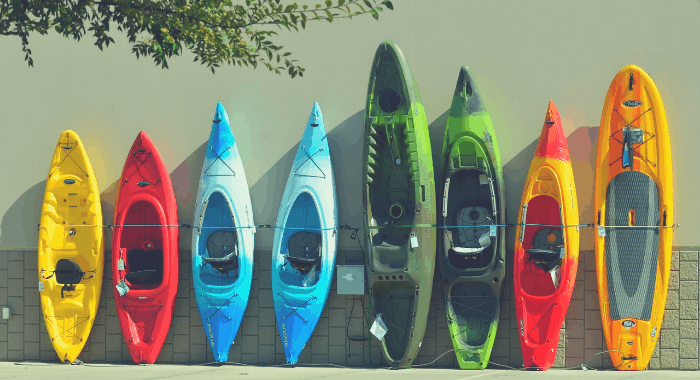
Length
Longer kayaks are easier to paddle, faster, more stable and can carry more load without affecting performance too much. They also track better, which makes them ideal in windy conditions or for long distances, such as sea kayaking or on big lakes.
On the flip side, shorter kayaks are less expensive and easier to maneuver in rapids. They’re also lighter, which makes transporting and storing them easier.
Width
A wider kayak is more stable, particularly in rapids, but it also requires more effort to move forward.
It’s also better to carry things, and lighter for transportation and storage.
Weight capacity and cockpit size
Apart from the kayak’s dimensions, you should also know that manufacturers make different cockpit sizes for different people. This means that some kayaks will be great if you’re 6ft tall, whereas others will be more suited to 5ft tall people, regardless of the kayak’s size per se.
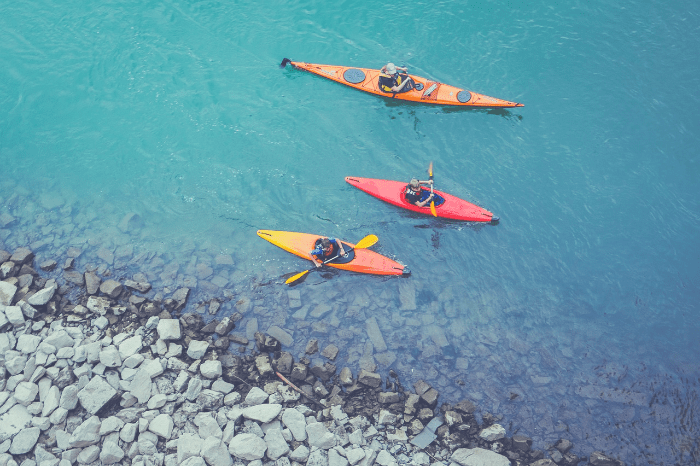
You should also check the weight capacity of your kayak before buying it, and account for the total weight − not only you and/or your partner but also everything you will carry as well as your kids, if applicable.
Finally, you should always try the kayak before purchasing it, for the reasons mentioned above. And by all means, do try several before making a decision, as this will help you make sure you are actually getting one that fits.
Trust me, there’s nothing worse than buying a kayak that’s too small for you and going on a painful and uncomfortable 3-hour trip that will make you hate kayaking forever.
Hull type
The hull is the bottom of the kayak, and its shape will determine both primary stability (when you get in and out) and secondary stability (while paddling).
There are essentially four types of hulls:
- Pontoon hulls: These are perfect for first-timers, as they have better stability than any other hull, both primary and secondary. Be aware that they won’t go as fast, though.
- Flat hulls: These are a bit faster than pontoon hulls, but have less secondary stability. They’re still very good for first-timers.
- Rounded hulls: These are faster, more maneuverable and have better secondary stability than flat hulls. Perfect for beginners that have already kayaked a few times.
- V-shaped hulls: These are the best of the best if you want to go fast in a straight line. They’re ideal for long-distance trips, whether on the sea or on a lake. They’re not as easy to get in and out, though, as they lack primary stability, but they have good secondary stability.
Material & Consequent Weight
If you’re passionate about kayak materials and you want to know how they are made in detail, read this thorough article on the different types of kayak materials.
But if you’re just interested in choosing the best kayak material for your first kayak, read on.
Rotomolded kayaks

These kayaks are made with a durable plastic shell and are generally suited for beginners. They’re the most inexpensive, but also the heaviest. Additionally, rotomolded kayaks are slower, harder to maneuver, and must be protected from UV rays.
That said, rotomolded kayaks can really take a beating, and will often bounce off rocks without any issue. This makes them great for whitewater kayaking.
Composite Kayaks

At the other end of the spectrum, you find composite or glass kayaks. These are the lightest and most expensive kayaks out there. They are really durable, but they will scratch easily on the sand or in contact with small rocks.
These are definitely not made to withstand impacts, so forget about using them in rapids. However, they make for perfect touring kayaks as they are the fastest of the bunch.
Thermoform Kayaks

Simply put, thermoform kayaks are a mix of both worlds. They are almost as light as composite kayaks while being as durable as rotomolded ones.
Their price is also pretty good and their design is often attractive to many. They also have UV protection, which is a good bonus.
Inflatable Kayaks

Inflatable kayaks are generally very similar to rotomolded kayaks, if not even less expensive. They’re definitely not the fastest or lightest, but they are very easy to carry and store.
Inflatable kayaks are generally best suited for recreational purposes, although you can find some fast and light ones on the higher end of the spectrum.
Folding kayaks

Folding kayaks carry the same benefit as the inflatable kayaks, which is that they can be transported and stored effortlessly.
However, they are more for advanced kayakers as they tend to be made with fiberglass. This makes them light and fast, but it also makes them prone to scratches and not as durable as plastic kayaks, particularly when it comes to direct impacts.
Additionally, the best folding kayaks tend to be even more expensive than rigid fiberglass kayaks. They also require more maintenance because of all the different parts.
How to Choose a Kayak – Summary
As you can see, choosing the best kayak depends on your intended use as well as your current kayaking skills.
Sometimes, people want to be able to do everything with one single kayak, and end up with a kayak that is suited for nothing.
To counter that, a good rule of thumb is to purchase a kayak that will match your use 90% of the time, without worrying about the other 10%. This way you won’t buy a kayak for that one time in a blue moon when you could need it, which would be the same as purchasing a panel truck as your daily car just because you’re going to move someday.
In the end, the best kayak for you is the one that will get wet the most. So pick the one that best suits you, and let’s get on the water!



